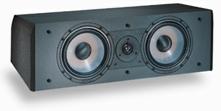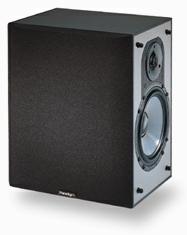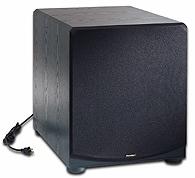|
September 1999 Paradigm Monitor-Series Home-Theater Loudspeaker System Paradigm has built a reputation as a manufacturer that provides its customers with a full range of high-value products. They build all manner of loudspeakers and subwoofers, and manufacture most of the components themselves. In fact, Paradigm manufactures three complete lines of loudspeakers, Performance, Monitor, and Reference. All of their speakers are suitable for use in two-channel stereo systems or they can be matched to the appropriate center-channel, surrounds and subwoofer to form a home-theater system. I counted 20 models of main speakers (including active models and those with powered subwoofers), five center-channel speakers, five surround speakers, and nine subwoofers in their excellent online catalog. With so many models in their product line ranging in price from under $200 up to $2000, Paradigm has a speaker solution for the value-conscious music or home-theater enthusiast no matter what the budget.
The review system consisted of a home-theater package that was comprised of Monitor 9 front speakers, a CC-350 center-channel, ADP-350 surrounds, and a PW-2200 powered subwoofer. This system is the top-of-the-line home-theater package in Paradigm's Monitor series. The Monitor 9s and PW-2200 were covered with an attractive dark cherry finish, while the CC-350 and ADP-350 were finished in a very durable-looking black "graphite" finish. The Monitor 9 is a floorstanding loudspeaker that utilizes two 8" polypropylene bass/midrange drivers and a single 1" tweeter along with a forward-radiating port. It is 37" H x 9.25" W x 14.25" D, frequency response is rated at 44Hz to 20kHz +/- 2dB, sensitivity is 90dB, and the recommended amplifier power is 15 to 200 watts. Spikes are included as are provisions for bi-amping or bi-wiring.
The ADP-350 is a dipole surround loudspeaker that
utilizes the same tweeter and bass/midrange drivers as the CC-350 and incorporates The PW-2200 is a powered subwoofer that features
an internal 250-watt amplifier, a single 12" polypropylene driver, and a rather large
rear port. Low-frequency extension (measured in a "typical" room) is listed as
18Hz. The high frequency cut-off is continuously variable from 50 to 150Hz and phase
alignment is variable from 0 to 180 degrees. Both line-level and speaker-level inputs and
outputs are provided for maximum flexibility in system integration. This is a All of these speakers look attractive, particularly with their grilles on. The cabinets are fairly solid and appear to be well braced. The CC-350 and ADP-350s are especially well built for speakers in this price range and have a very solid feel to them. Bass extension for all but the subwoofer are quoted as anechoic measurements, so usable bass frequencies should be even lower in most rooms. Because of the speakers’ superior power handling characteristics and above average bass response, I ran all of the Paradigm speakers full range during playback of Dolby Digital and DTS soundtracks. System Processing and amplification were provided by a Technics SF-DX6 combo (SH-AC500D processor and SA-AX6 receiver), a Sherwood Newcastle AVP-9080R pre/pro, and a Carver AV-705X power amplifier. Sources were a Panasonic A110 DVD player and a Pioneer Elite CLD-59 laserdisc player. Cabling and interconnects were by AudioQuest, Straight Wire, Monster, Mogami, and Ultralink. Speaker levels were calibrated utilizing the Dolby Digital test signals from Video Essentials [DVD International DVDI 0711] and a Radio Shack SPL meter. The Paradigm system replaced a pair of Definitive Technology BP-10s (mains), Boston 555X (THX center), NHT 1.5s (surround), and a Sunfire True Subwoofer. The Monitor 9s and PW-2200 also spent some time in a two-channel rig consisting of a Roksan Caspian CD player and integrated amp. Up front Prior to setting up the Monitor 9s, I suspected that they would make good home-theater loudspeakers with adequate performance on music material. I also suspected that they might suffer from problems integrating the midrange and treble due to their use of two rather large 8" drivers. Much to my surprise and delight, the Monitor 9s handled movie soundtracks and music equally well. Both of which were reproduced with authority and finesse. These speakers had all the dynamics and power handling that would be expected of a floorstanding home-theater design as well as the accuracy and resolution of a good monitor. Imaging was also exceptional and there was a distinct lack of any obvious coloration. Much of the sound quality that I am accustomed to from "high end" loudspeakers was exhibited by the Monitor 9s. Front and center The CC-350 matched the timbre of the Monitor 9s perfectly and never brought attention to itself unlike a lesser or more poorly matched center channel speaker might. However, it did tend to get slightly congested at very high levels that were not a problem for the Monitor 9s. This problem could be mostly alleviated by utilizing bass management to roll off some of the low frequencies being directed to it. Even with these minor power handling problems (something not uncommon among center channel speakers), the CC-350 is still vastly superior to most of the competition in its price range.
Flanking positions The ADP-350s are excellent surround speakers that sound incredibly natural and image very well. Although I enjoy the diffuse sound of dipole surrounds, I often find that they lack a certain neutrality and truth of timbre. The ADP-350s strike a successful balance between the enveloping sound of dipoles and the detail and clarity that are normally associated with direct radiating speakers. They also have excellent power-handling capabilities and were able to reproduce the dynamics of discrete digital soundtracks without any signs of distress. Down low Although the Monitor 9s handle bass quite well, most home-theater systems require the use of a subwoofer to reap the full benefits of discrete digital soundtracks. The PW-2200 admirably reproduced the .1 LFE channel of the Paradigm system. Bass was always tight and tuneful and extended down to 20Hz (according to my Radio Shack SPL meter) with very little apparent distortion. Although bass performance was very good, it did not pound. If more bass is required you may want to consider Paradigm's impressive Reference Servo-15 subwoofer reviewed by Frank Alles. Sum of the parts The Dolby Digital soundtrack of the Saving Private Ryan LD [Dreamworks ID 5916DW] is one of the best soundtracks that I have ever heard and sounds amazing on the Paradigms. Although the opening battle scene is incredibly dynamic with bullets and explosions creating a virtual 360-degree soundstage, I preferred the final battle scene in the village due to its subtlety and greater sense of depth and space. Con Air on DTS LD [Touchstone 12881 AS] tested the mettle of the Paradigms with a soundtrack that requires the ability to image at very high SPLs. In Chapter 14: Attack, a fierce firefight is followed by a plane taking off that knocks down several fence posts all of which are reproduced with remarkable realism. Interior scenes in Whipstaff Manor on the Casper DTS LD [MCA/Universal 43120] sounded unbelievably spacious and produced a holosonic, three-dimensional soundstage. Multichannel and straight two-channel music reproduction were not a problem for the Paradigms. They delivered all the detail, smoothness, and transparency that could be expected of them and more. Coloration was minimal on strings, horns, and other acoustic instruments resulting in a very neutral and transparent sound. I was totally unprepared for the level of performance delivered by these speakers. Playing back the isolated 5.1 music score of The Sweet Hereafter DVD [New Line N4654] was a haunting experience. Mycheal Danna’s Celtic inspired musical score was reproduced with deep, tight bass and an enveloping soundfield that totally immerses you in the film. While watching the Eagles: Hell Freezes Over on DTS DVD [Geffen ID5479EADVD], I was struck by how clean and powerful the guitar chords of Joe Walsh and Don Felder sounded and how they imaged outside of the two front speakers. The Titanic Soundtrack on DTS CD [Sony Classical 71021-51026-2-7] also sounded wonderful. Choral passages floated between the main speakers with an ethereal quality and Sissel’s vocals emanated effortlessly from the center channel, which blended perfectly with the mains. Holly Cole’s vocals on Don’t Smoke In Bed CD [Alert Z2 81020] were smooth and natural and lacked much of the sibilance that often plague inferior speakers on this recording. David Piltch’s bass was slightly exaggerated, but still very listenable, and Aaron Davis’ piano was equally enjoyable and surprisingly natural. Checking the score While the Monitor 9s could not match the power-handling capabilities or bass output of my reference BP-10s, they did image better and were smoother and less colored. My NHT 1.5 surrounds exhibit better imaging and tighter bass, but the ADP-350s have greater envelopment and ambience. The similarly priced Phase Technology PC Surrounds that were recently on hand for review seemed to have an even more enveloping soundfield, but did not image as well and were boomier than both the Paradigms and the NHTs. The CC-350 plays louder and has better bass extension than any other center-channel speaker that I have heard in this price range. Although my Boston Acoustics 555X (which is THX certified) is a little more detailed and cleaner in the midrange, the bass rolls off much more quickly and as such it does not have the same impact as the Paradigm. The PW-2200 matched my Sunfire True Subwoofer in low-frequency extension, but it was no match for it in terms of sheer output. The Sunfire handles movie soundtracks with a power and authority that the PW-2200 could not equal. We have a winner . . . The Paradigm Monitor 9, CC-350, ADP-350, PW-2200 home-theater system is a tremendous value. While none of the speakers is a stellar performer, all of the pieces work together in a near-perfect synergy with no major shortcomings. Power handling, accuracy, detail, and imaging were all exemplary for a system at this price point. At no time while I was auditioning these speakers did I ever feel that I was missing something. Whether I used them with the modest Technics SF-DX6 processor/receiver combo or with a Sherwood Newcastle AVP-9080R pre/pro and a Carver AV-705X power amp, the Paradigms always delivered a satisfying and extremely involving listening experience. While there are certainly more expensive home-theater systems that will out perform these speakers (including some from Paradigm), you may ask yourself, as I did, whether the added performance and associated expense is really necessary. Even though I normally listen to much more expensive two-channel speaker systems, I thoroughly enjoyed my time with this Paradigm home-theater system. ...Roger Kanno Manufacturer Contact: Website: www.paradigm.ca US distributor: GO TO |
|||||
| Copyright
© 1999 SoundStage! All Rights Reserved |
![[SOUNDSTAGE!]](../../titles/sslogo3.gif) |

 Roll call
Roll call The CC-350 is a magnetically
shielded center-channel utilizing the same 1" tweeter as the Monitor 9 and two
smaller 6.5" bass/midrange drivers. It is 7.5"H x 22.75"W x 9.75"D.
Frequency response is 70Hz to 20kHz +/- 2dB, sensitivity is 87dB, and the recommended
amplifier power is 15 to 175 watts.
The CC-350 is a magnetically
shielded center-channel utilizing the same 1" tweeter as the Monitor 9 and two
smaller 6.5" bass/midrange drivers. It is 7.5"H x 22.75"W x 9.75"D.
Frequency response is 70Hz to 20kHz +/- 2dB, sensitivity is 87dB, and the recommended
amplifier power is 15 to 175 watts.  Paradigm’s Reverberant Soundfield technology. Two pairs of the
tweeter and bass/midrange drivers fire in opposite directions that are said to be
"optimized with differing radiation patterns at various frequencies to ensure both
timbre accuracy and a very large reverberant soundfield." The speaker measures
13"H x 11.4"W x 8"D. Its frequency response is rated at 75Hz to 20kHz
(reverberant soundfield), sensitivity is 87dB, and the recommended amplifier power is 15
to 175 watts.
Paradigm’s Reverberant Soundfield technology. Two pairs of the
tweeter and bass/midrange drivers fire in opposite directions that are said to be
"optimized with differing radiation patterns at various frequencies to ensure both
timbre accuracy and a very large reverberant soundfield." The speaker measures
13"H x 11.4"W x 8"D. Its frequency response is rated at 75Hz to 20kHz
(reverberant soundfield), sensitivity is 87dB, and the recommended amplifier power is 15
to 175 watts. moderately sized subwoofer at
19.75"H x 16.5"W x 21.6"D, but it is significantly deeper than it is wide
which gives it a look that is more svelte than that of your typical sub.
moderately sized subwoofer at
19.75"H x 16.5"W x 21.6"D, but it is significantly deeper than it is wide
which gives it a look that is more svelte than that of your typical sub.